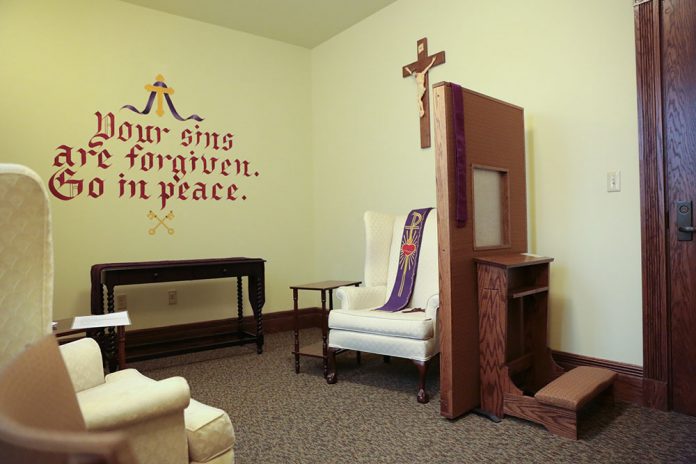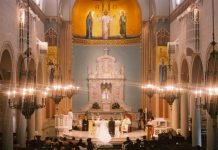
by Kate Ristow
A Timeless Definition
Generations of Catholics grew up learning by rote the Baltimore Catechism definition of a Sacrament: “an outward sign instituted by Christ to give grace.” For many of us, the words had little meaning; they were just something we were required to memorize. In time, though, through a combination of formation, experience, and maturity, we grew in our understanding of the deeper meaning behind that definition.
“Outward sign” was the easiest part. We understood signs! A cake and candles represented a birthday. Fireworks and a parade were integral parts of celebrating Independence Day.
Even as young children, we saw that Church celebrations were centered around signs—the pouring of the water, anointing with oil, drinking from the cup or sharing the bread. These were what theologians call the “matter” of the Sacraments. These signs were the “what” of the ritual, the action. In the “matter,” we understood what was received or done in celebrating the Sacrament.
“Grace,” too, was something we were able to grasp in relationship to the Sacraments. Grace was a gift, a present from God. In time we learned that grace was the gift of God’s life and presence that made us holy. We could not earn grace; we received grace through the Sacraments.
This is not to say that we understood exactly how God gave us grace; like so many other beliefs of the faith, it was part of the great mystery of God’s love for us. As we grew in faith and in our ability to understand deeper concepts, we learned about the different kinds of grace: sanctifying grace (which enables us to share in God’s life) and actual grace (through which God helps us choose good and to avoid sin).
Did Jesus Invent the Sacraments?
The easiest part of the definition—or at least it seemed so at the time—was the middle section: “instituted by Christ.” Most kids—and adults, too, no doubt—took that to mean that Jesus invented the Sacraments.
But think about it. There were married people in the Old Testament and Jesus worked his first public miracle at a wedding, so he could not possibly have invented Matrimony. There were priests in the Old Testament, even a priestly tribe descended from Levi, one of Jacob’s twelve sons. So, again, Jesus clearly did not invent the priesthood. How about Reconciliation? At 2 Samuel 12, David confesses his sin to Nathan and is forgiven by the Lord. In Matthew 3, John the Baptist urges people to repent to prepare for the coming of the kingdom. Jewish people today continue to celebrate Yom Kippur, or the Day of Atonement, first described in Leviticus 23:27.
The list goes on, but it is clear that there is a relationship between biblical rituals and the Sacraments as we know them today.
Did Jesus Institute the Sacraments?
The reality is, we can find the roots of many of our sacramental rituals in the Old Testament. So why do we say that Jesus instituted the Sacraments?
Remember that through his life, death, Resurrection, and Ascension, Jesus fully revealed the Father to us. In Jesus, God established the new and everlasting covenant. Jesus came to fulfill the Old Law, the Law of Moses and the Prophets.
Jesus did this in all aspects of his ministry, so it is important to recognize that, in speaking of the Sacraments, Christ did not simply put new wine in old wineskins. The Lord did not merely “Christianize” the sacred rituals we now call Sacraments. Theologians tell us that although Jesus instituted the Sacraments, it does not mean that he determined the names of the Sacraments or even how they were to be celebrated.
Rather, in his ministry, Jesus recognized key human experiences, needs, and transitions and imbued them with grace—his life-giving presence. Then, beginning with the Apostles, the Church continued and institutionalized this tradition in the celebration of the Seven Sacraments.
Today, when we teach children about the Sacraments, we use age-appropriate language that can be developed and expanded as children grow in faith. Yet, no matter how old our students are, any definition of a Sacrament will include these three key elements: sign, grace, and Christ. These concepts are at the heart of the definition for Sacrament found in the Catechism of the Catholic Church: “The sacraments are efficacious signs of grace, instituted by Christ and entrusted to the Church, by which divine life is dispensed to us. The visible rites by which the sacraments are celebrated signify and make present the graces proper to each sacrament” (n. 1131).
The Development of the Sacraments
The word sacrament is derived from two sources: the Latin word sacramentum, which means “oath” or “pledge” and the earlier Greek term mysterion, which means “mystery,” referring to the hidden nature of God’s plan that enlightens only those who have faith. In ancient times, soldiers would swear an oath to their commander. As a sign of their pledge, they were branded on the arm, leaving them with an indelible mark. Tertullian, a third-century theologian, used this secular practice to explain the indelible character we are graced with in Baptism. Confirmation and Holy Orders also confer an indelible mark that “remains for ever in the Christian as a positive disposition for grace, a promise and guarantee of divine protection, and as a vocation to divine worship and to the service of the Church” (Catechism of the Catholic Church, n. 1121).
Our sacramental theology developed over time. After his Ascension, Jesus worked through the Apostles and the Church. Many of the practices we now term “sacramentals” were considered sacraments by the early Church. Saint Peter Damian (1007-1072), a Doctor of the Church, declared that there were 12 sacraments. The renowned theologian Peter Lombard (1100-1160) was reportedly the first to narrow the number to seven. This was affirmed at the Council of Florence in 1439, but the Seven Sacraments were not fully defined until the Council of Trent in 1551.
Enrichment Activities
Defining and explaining what happens in each Sacrament gives kids roots—a foundation to build on. We also need to give our students sacramental wings—opportunities to explore and deepen their understanding of these “masterworks of God” (CCC, n. 1116). Here are five ideas to get you started.
1. Role Playing and Dramatization
Whether we teach first graders or junior-high students, almost nothing helps children understand how a sacramental rite works better than acting it out. It can be as simple as having primary-age kids solemnly take turns pouring water gently over a life-sized doll’s head as they say, “(Name), I baptize you in the name of the Father, and of the Son, and of the Holy Spirit.”
Older kids can take the parts of the priest, parents, godparents, and assembly, and use props to reenact the entire ritual from the anointing with chrism to the presentation of the baptismal candle.
Role playing and dramatization is also an effective technique for teaching about Reconciliation, the proper way to receive the Eucharist, Confirmation, and Matrimony.
2. Computer-Generated Presentations
This is definitely a home-based project because the kids will need personal computers or digital cameras to prepare their presentations. Assign the project at the beginning of a unit on the Sacraments so that the kids have plenty of time to work on them. Have students work in pairs or small groups to create short presentations—ten to fifteen slides/pictures at most—about the Sacraments in general or a specific Sacrament.
For example, a presentation on Baptism might focus on the primary symbols: life-giving, flowing water; light; and being clothed in a white garment. A Confirmation presentation can begin with a recollection of the coming of the Holy Spirit (Acts 2:1-4) to the disciples and segue into slides that show how we celebrate Confirmation today. Older students will enjoy using both their creativity and knowledge to complete this project.
Another approach might be to challenge students in middle school to prepare slide presentations to teach second-graders about Eucharist and Reconciliation.
3. Guest Speakers
Kids at every grade level love greeting and learning from V.I.P. class visitors, and such visits are perfect opportunities to involve active parishioners who cannot devote a full year to participating in your program. Consider inviting a minister of care to talk about the ways the parish reaches out to the sick, thus continuing Jesus’ mission of healing. Ask a teen who worked on a Habitat for Humanity house, spent Easter break repairing homes in Appalachia, or sets up cots and prepares meals at a local overnight shelter to talk about how these efforts are ways of living out his or her baptismal commitment.
If possible, visit a local seminary and arrange for some of tomorrow’s priests to talk with the kids about what priesthood means to them. If you do not have a seminary in your area, call the rector of a major seminary to arrange a Skype session with a few of the seminarians and your class. Provide a list of interview questions that you and the students have developed together in advance.
4. Sacrament Crafts
Have students use air-drying clay to create symbols representing the Sacraments in general or a specific Sacrament. Give the class ample time to complete the project and then call on volunteers to explain their symbols to the class. This makes an excellent wrap-up activity at the end of a unit on the Sacraments.
As an alternative, have students make triptychs on tagboard or poster board with each panel illustrating one of the three defining elements of the traditional definition of a Sacrament—outward sign, instituted by Christ, to give grace.
5. Visit the Church
Take your class to the church and point out the ambry, where the sacramental oils are kept. Gather around the baptismal font and have the children sign themselves with the water, thanking God for making them his children in Baptism. If you are fortunate enough to have stained glass windows depicting the Sacraments, study them with the class.
As an alternative, take a field trip to another church with windows illustrating these seven signs of Christ’s presence—perhaps your cathedral church or a neighboring parish. Afterwards, have the kids find a quiet place in the church, give them paper and pens, and invite them to write prayers thanking Jesus for the gift of the Sacraments.
Jesus, Sacrament of God
Saint Augustine (354-430) defined the Sacraments as “visible signs of invisible grace.” He taught that through the mystery of the Incarnation, when Jesus took on human flesh while remaining fully divine, Jesus became our first, or primordial, Sacrament. God revealed himself most fully in Jesus. Jesus Christ is our visible sign of the invisible God. We call Jesus the “Sacrament of God” because he made God known to us.
The Church, too, is properly called a Sacrament. The Church is the Body of Christ. We are called to be a visible sign of Jesus in the world today, channels of God’s grace for one another.
Kate Ristow, Contributing Editor to CATECHIST, has worked in Catholic publishing for over 25 years as a national speaker and writer, building on a wealth of experience in the religious formation of children and catechists in both parish and Catholic school programs.
Copyright 2012, Bayard, Inc. All rights reserved. This article is protected by United States copyright and other intellectual property laws and may not be reproduced, rewritten, distributed, redisseminated, transmitted, displayed, published or broadcast, directly or indirectly, in any medium without the prior written permission of Bayard, Inc.




